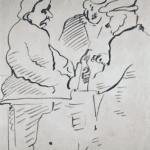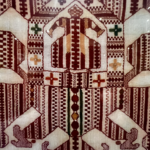This exhibition presents over 100 religious images and crosses made from various copper alloys and decorated with multicolor enamel and gilt. The variety of forms, iconography, design and decoration of these icons and crosses, created by Old Believer communities from the 18th through 20th centuries features images of patron saints, personal crosses and skladen icons (icons with foldable side flaps). The exhibition is drawn from the private collection of Minnesota art lover and musician Edward Stack.
Cast Icons: Preserving Sacred Traditions will feature over 100 metal icons and crosses, cast from the 18th to the 20th centuries.
Illuminating the rich tradition of religious icons in Russian Christianity, this exhibition covers the great importance of metal cast icons in pre-Soviet Russia. With discussion of the history and customs of the Old Believers, a persecuted church, this exhibition offers a window into the complex historical background of some of Russia’s religious practices. The exhibition features traditional church crosses, portable icons and triptychs of saints and the Holy Family used by Old Believers.
The exhibition explores icons cast in copper alloys such as brass and bronze, and decorated with gilding and enamel. Learn about the materials and techniques used to make and decorate these icons. A hands-on display will give visitors a better understanding of the physicality of the icons and will allow them to consider what it would have been like to carry these sacred objects in daily life
In the 17th century, the powerful Russian Church split over the harsh and swift reforms introduced by Patriarch Nikon. Millions of believers turned away from the official church to set up independent religious communities adhering to the Old Faith. Thereafter, the Old Believers became the foremost producers of cast icons, especially after Peter the Great prohibited the use of cast and carved religious icons both in churches and in the home in the 18th century.
Old Believers settled in the northern and eastern regions of Russia. In the late 17th century, an Old Believer monastery was founded on the Vyg River in Karelia and a foundry was set up for the production of cast icons and crosses. These objects, their iconographies and their molds were disseminated throughout Russia and served as models for foundries in larger production centers such as Moscow. Metal icons were durable, easy to carry and resistant to damage. Therefore they became ubiquitous with the Old Believers who were forced to move around frequently. Hung over entrances to houses, stables and cattle barns, cast icons protected the homeowners.
With Old Believer foundries scattered across the Russian Empire, peddlers sold crosses and icons of bronze and brass at fairs. Members of both ‘official’ and ‘persecuted’ churches bought them for their personal prayer needs. Cast Icons: Preserving Sacred Traditions demonstrates the vast beauty of Russian cast icons, their immense importance to the official and persecuted churches and the great variety of purposes for which they were used.
About the collector: Edward Joseph Stack has been a violinist in the Minnesota Orchestra for the past 46 years and has had the opportunity to travel the globe. In the early 1990s, on a tour with the Orchestra in Frankfurt, he purchased his first metal icon from Polish dealers in a market. Particularly interested in collecting spiritual art, he says, “I feel a joy to collect and protect these spiritual pieces and am privileged to enjoy their radiance.”


